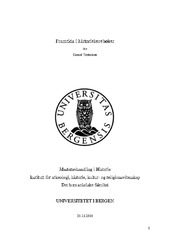Framtida i historielærebøker
Master thesis
Permanent lenke
https://hdl.handle.net/1956/18936Utgivelsesdato
2018-12-18Metadata
Vis full innførselSammendrag
I denne oppgåva analyserer eg tre historielærebøker frå vidaregåande skule. Målet er å kunne seie noko om kva forventningar om framtida dei legg til rette for. Føremålet er å synleggjere framtidsdimensjonen i historiebøkene. Eit viktig aspekt ved historiedidaktikken har vore korleis fortida, samtida og framtida påverkar kvarandre. Denne oppgåva lener seg på forståinga av at kunnskap om fortida formar kva vi venter oss av framtida, og korleis dette blir realisert i historielærebøker. For å finne fortidsdimensjonen har eg nytta Fortalt fortid sine forteljingsomgrep. Og blant anna tropane til Rüsen. Hovudfunna er at framtida ber preg av truslar og usikkerheit i lærebøkene. Og at forståingrammer rundt hendingar er eit viktig reiskap til å gjere fortida relevant til samtida og seie noko om framtida. In this thesis I analyze three contemporary history textbooks from the Norwegian high school. With the goal of saying something about what future expectances they hold. The purpose is to visualize the future dimension of history. An important aspect of history didactics has been how the past, the present and the future affect each other. This thesis lean on the understanding that knowledge of the past shape what we can expect from the future, and aim to say something about how this is realized in history textbooks. In order to clarify the past dimension in the books, I have benefited from the project Fortalt fortid. Both how they see the narrative as a fundamental way of understanding the past, and how they use the narrative as an analytical tool. I have also used, among others, the typology of Jörn Rüsen to discuss what function the narratives may have. The main findings in this thesis is that the future in the textbooks are characterized by threats and uncertainty. The analyses also shows that putting the past into a framework of understanding, makes the past emerge as more relevant in the present, and points out a clearer direction for the future.
